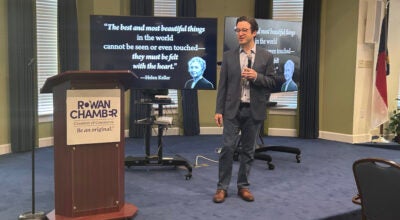Published 12:00 am Saturday, August 11, 2012
By Emily Ford
eford@salisburypost.com
SALISBURY — Bad air is costing Rowan County jobs.
No one knows how many jobs, but air pollution in Salisbury and Rowan keeps certain manufacturers from even considering the area for a new plant or the expansion of an existing facility.
Most of Rowan County is included in a designated area surrounding Charlotte where ground-level ozone measurements are too high.
“In many cases, this prevents Rowan County from bringing all the other advantages the county has to offer to the table, because the company just doesn’t want to deal with the nonattainment issue,” said Mark Sweeney, senior principal in McCallum Sweeney Consulting, a site selection firm in Greenville, S.C.
Like the pollution that causes it, nonattainment is a dirty word in economic development circles.
Rowan is one of seven counties in the Charlotte nonattainment area. The others are Mecklenburg and parts of Iredell, Lincoln, Gaston, Cabarrus and Union counties.
The designation means the region has not attained the EPA’s eight-hour ozone standard, which is 0.075 parts per million.
Ground-level ozone is the main component in smog. It’s unhealthy to breathe and can damage trees and crops.
Companies using just about any heat-based process that causes VOC emissions, which form ozone, eliminate Rowan and other nonattainment counties early during the search process, Sweeney said. Examples include some furniture manufacturing and auto parts manufacturing.
“You’re just not even going to be considered for many manufacturing projects that have some discharge,” he said.
Time and money
For manufacturers that add to ozone levels, opening a plant or expanding an existing facility in Rowan would take too much time and cost too much money, Sweeney said.
Rowan and other nonattainment counties have three strikes against them, Sweeney said:
• The permitting process is more demanding, and companies may have to use more pollution-control technology than they anticipated to reduce emissions. That costs more money.
• The state and federal permitting process takes longer than normal and could keep a company from meeting crucial development deadlines.
• There’s no guarantee.
“You don’t know what the end result is going to be. There is no comfort level that you will get your permit,” Sweeney said. “It costs more and takes longer, and there’s an element of uncertainty.”
Money and time are tough deterrents, said Robert Van Geons, executive director for RowanWorks Economic Development.
The requirements could add up to a year to the permitting process.
Companies with an industrial process that triggers additional pollution-control measures in Rowan County “will naturally look at going where it’s easier,” Van Geons said.
As counties fight for every post-recession economic development project, companies have many choices for new locations.
“Our clients are looking for minimal risk and a minimally scheduled location,” Sweeney said.
While nothing prevents a company with VOC discharge from locating in Rowan or another nonattainment county, “it’s extremely rare,” Sweeney said.
In fact, he couldn’t think of one.
Existing industry in a nonattainment area will look elsewhere to expand rather than face requirements to install pollution-control technology on not only new construction, but retrofit older parts of the plant as well, Sweeney said.
Some progress
People are breathing easier in Salisbury-Rowan as the air quality improves.
The Environmental Protection Agency rewarded the county in May by approving the state’s recommendation to exempt four townships from the nonattainment area — Scotch-Irish, Cleveland and Mount Ulla in the northwest and Morgan in the southeast.
Now, industries can set up shop in those areas with no additional pollution-control requirements.
“The exemptions show we are making progress,” Van Geons said.
They also open up economic development opportunities for Rowan along N.C. 70 and N.C. 52, he said.
The exemptions became effective July 20, so it’s too early to tell whether interest will pick up in those areas from manufacturers who would otherwise eliminate Rowan entirely.
The state recommended exemption because the townships are rural with little traffic, said Tom Mather, a spokesman for the N.C. Division of Air Quality.
Van Geons would like to see the entire county removed from the Charlotte nonattainment area but pointed out Rowan’s pollution problems are largely caused by others.
“It’s not an issue of where the emission takes place, it’s where the air ends up,” he said.
Van Geons said he would like regional players to have a discussion about generating ways to improve air quality across the board, “with a recognition that Rowan County’s nonattainment status in general is not generated by Rowan County businesses or citizens.”
While the exemptions are good news for Rowan and could attract industry, some companies will continue to avoid the county altogether, Sweeney said.
“From our standpoint, there is still an element of risk,” he said. “You are not free and clear.”
A company could be concerned that the government would change the pollution standard, throwing the entire county back into nonattainment, he said. Or a manufacturer with discharge may worry the company itself could trigger higher measurements.
The number of companies that eliminate Rowan based on air pollution is a small minority of total projects looking for a new location, Van Geons said.
“Nonattainment areas in the state have had some of the largest growth — Charlotte, the Triangle and Greensboro,” Mather said.
The Triangle, Winston-Salem and Greensboro all have been removed from nonattainment status. The Charlotte-Metrolina area remains the only ozone nonattainment area in the state, although the Wilmington area could receive a nonattainment designation for sulfur dioxide, Mather said.
Rowan is home to a number of green industries, from MaxLife Roof Tiles, which makes a concrete roof tile containing a catalyst that can help reverse air pollution, to RDH Tire that uses a process to extract oil and gas and other products from scrap tires.
The county’s commitment to the environment is growing, Van Geons said, but Rowan needs the same commitment from nearby sources of pollution.
“We need to continue to make progress towards this,” he said. “Every hurdle we can eliminate gives us access to more potential projects.”
Contact reporter Emily Ford at 704-797-4264.




